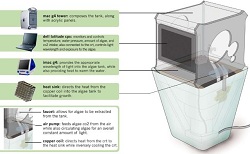 Usually, we talk about using high-tech computer programs to help producers get more biodiesel out of their operations. But this time, it’s the low-tech components that are the platforms for growing a feedstock for the green fuel.
Usually, we talk about using high-tech computer programs to help producers get more biodiesel out of their operations. But this time, it’s the low-tech components that are the platforms for growing a feedstock for the green fuel.
Treehugger.com has this post about how students at the University of Illinois at Urbana-Champaign have put together an algae bioreactor called the Bio-Grow to cultivate large amounts of algae for biodiesel using old computer parts:
“If someone had one of these in their homes, they would cultivate algae and extract it,” says Megan Kenney, one of the members of the five-person undergraduate team. “Then they could take it into a gas company that was set up with an oil filtration facility and get credit off their gas.”
The Bio-Grow’s various components would include side panels from an Apple G4 CPU tower for the incubating tank, with PVC pipes for structural reinforcement and high density foam for insulation and stability. An old Apple iMac CRT provides the light needed for photosynthesis, while a modified Dell Latitude CPX laptop controls and adjusts the temperature and required light spectrums generated by the iMac CRT. The device also features a water pump to aerate the algae and a faucet that allows user to harvest the algae at any time.
“Algae’s best growth factors are within the red and blue spectrums of light at a ratio of four to one,” Kenney explains. “We also knew that it needed to be 62 to 82 degrees.”
The hope is that people will be able to grow algae as part of a larger system and take that algae to a central collection point. The lipids in the algae would be extracted and sent to a refinery to make biodiesel, while the by-products would go into livestock feed, fertilizer and pharmaceuticals. The Bio-Grow team believes just under 7 percent of American homes would need to have a device to grow enough algae to replace petroleum with algae biodiesel.

